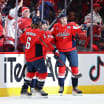Is it a matter of communication, knowing where Tarasenko is at all times?
"It's a bunch of different things. For myself, it's putting the puck in areas where he wants it. For a one-timer, it's getting it in the right spot so he can get the perfect shot out of it. Or areas where he creates space, I want to get the puck over to those. It's just all these little things that happen through playing a game. Practice can help a bit, but it's more [about] those game situations, seeing and getting reads on guys and making adjustments with him. There are always little elements that keep progressing."
You're one of the best in the NHL at face-offs (61.9 percent). What works for you?
"I think it's a combination of everything. I have a stiff stick. Some guys use sticks that are a lot whippier, which helps them with shooting the puck more. But it gives me an advantage because my stick's stronger in there, so a lot of times I'll get good bounces through face-offs. It's having good wingers, too, giving them an idea of, 'Hey, the puck's most likely going to be in this area if I lose it.' Sometimes they jump in and win the draw for you, that kind of thing. It's being strong on the stick and strong in your core. Now what works for me doesn't work for someone else. Everyone's different. Some guys are just very hand-eye, getting the puck clean. Some guys, like me, just lean on their sticks heavy. Some are more tie-up and win draws that way. There are different elements to it. It's definitely a unique skill for everyone."



















